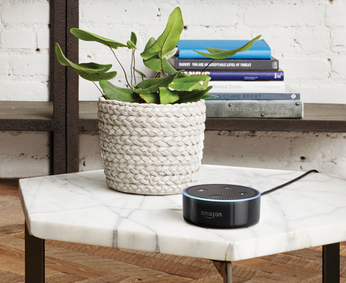Programming Snapshot – Alexa
Equipping Alexa with self-programmed skills

Asking Alexa only for built-in functions like the weather report gets old quickly, and add-on skills from the skills store only go so far. With a few lines of code, Mike teaches this digital pet some new tricks.
Okay, I admit, I don't like getting up from the sofa to check out something on the Internet if my phone is out of reach. But who does? In the household of the future, a device like Amazon's Echo will be around to help you with things like this in the form of a tin can in the living room. The Amazon Echo Dot, which looks much like a hockey puck (Figure 1), is the successor to the tin-can-like Echo device and offers the same voice interface at a lower price point.
Amazon's dream, of course, might be that customers at home will just shout "Alexa, order toilet paper," to send the language assistant scurrying off to place the order with the Internet discounter, who then quickly dispatches a drone to deliver the much-needed household item to the anxiously waiting consumer.
[...]
Buy this article as PDF
(incl. VAT)
Buy Linux Magazine
Subscribe to our Linux Newsletters
Find Linux and Open Source Jobs
Subscribe to our ADMIN Newsletters
Support Our Work
Linux Magazine content is made possible with support from readers like you. Please consider contributing when you’ve found an article to be beneficial.

News
-
Two New Distros Adopt Enlightenment
MX Moksha and AV Linux 25 join ranks with Bodhi Linux and embrace the Enlightenment desktop.
-
Solus Linux 4.8 Removes Python 2
Solus Linux 4.8 has been released with the latest Linux kernel, updated desktops, and a key removal.
-
Zorin OS 18 Hits over a Million Downloads
If you doubt Linux isn't gaining popularity, you only have to look at Zorin OS's download numbers.
-
TUXEDO Computers Scraps Snapdragon X1E-Based Laptop
Due to issues with a Snapdragon CPU, TUXEDO Computers has cancelled its plans to release a laptop based on this elite hardware.
-
Debian Unleashes Debian Libre Live
Debian Libre Live keeps your machine free of proprietary software.
-
Valve Announces Pending Release of Steam Machine
Shout it to the heavens: Steam Machine, powered by Linux, is set to arrive in 2026.
-
Happy Birthday, ADMIN Magazine!
ADMIN is celebrating its 15th anniversary with issue #90.
-
Another Linux Malware Discovered
Russian hackers use Hyper-V to hide malware within Linux virtual machines.
-
TUXEDO Computers Announces a New InfinityBook
TUXEDO Computers is at it again with a new InfinityBook that will meet your professional and gaming needs.
-
SUSE Dives into the Agentic AI Pool
SUSE becomes the first open source company to adopt agentic AI with SUSE Enterprise Linux 16.


